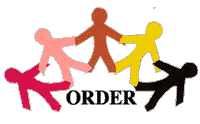

©2005 Circle of Friends Publishing. All rights reserved
CREATING MUSIC AND CREATIVE FAMILIES (As seen in Tumbleweeds, Sante Fe N.M., September 1996)
by Justin Miera © 1996
Music is one of the most spontaneous and accessible forms of creativity available to both adults and children. I know some people are thinking, easy for you to say...I can't even carry a tune, nevertheless create music. The trickiest part is not the music, but the creativity. Once we get beyond the "I can't" it's smooth sailing for both you and your children. You have everything you need to write a musical composition, perform it with your family and start a valuable family tradition.
Sound is a great place to start. We can make sounds with bodies, voices, instruments, kitchen utensils, toys, natural objects, recyclable objects or anything you can find. While formal instruments sound familiar they are more difficult to learn, so find something that you are comfortable with, percussion is the easiest. Add new sounds and instruments as you become accomplished with these activities. Next, we will organize our sounds.
One easy way to organize sound is to set the instruments and performers in a series. This is where everyone joins in. The first person plays, then the second, and on around the circle. You can play loud or quite, fast or slow, with a beat or just plain crazy. Now, let's all get a steady beat going and sing or chant this piece with the music:
(all) The Johnson's band is coming to town, coming to town, coming to town.
The Johnson's band is coming to town, all the live long day.
(Person 1) This is how the wood block sounds, wood block sounds, wood block sounds.
This is how the wood block sounds, all the live long day.
Each person takes a turn showing off their sound and then everyone plays together at the end. Apply the same idea to a familiar song like Old McDonald, Wheels on the Bus or Hockey Pockey. Just use your sounds in place of the animals, what happens on the bus and the body parts. This isn't a symphony, yet, but it gives children a great opportunity to be inventive and explore their resources.
To create our own original rhythm song cut out different shapes, or colors, for each sound to be used. Arrange the shapes to create an order. Try combining two or three sounds at one time, or just have a solo shape. Play the composition, ask yourselves what can we change, and then try the new one. Add new shapes or colors to symbolize loud/quite or fast/slow. Make up one rhythm to carry through the piece or different rhythms for each section. The possibilities are virtually limitless.
Now, let's put lyrics to this piece. Help your children to write a sentence about something in their lives, then chant it with one of the sections from your rhythm composition. You can write a different line for each section, or leave some sections instrumental. The rap music of today is much like this chant, but more intricate. Rap is usually based on some type of poetic rhythm (e.g. iambic hexametor)...and then performed with an attitude. Nursery rhymes make great first raps. Once the rhythm of the words feels comfortable begin moving the pitches around, some high, some low and some the same. Play with it a while till the melody is just right.
A fun way for everyone to sing a verse is to set-up a "blues." Each person make their own sentence, repeat it a second time, and on the third time use a different sentence to compliment the first. In a traditional blues each line is sung for 4 measures, or 16 counts. At three lines you have a total of 12 measures, or 48 counts. With young children this kind of symbolic representation may not be successful, let them take as long as they want. The elementary age children can truly thrive on interdisciplinary activities like this because the math, language and music compliment each other.
Another way to have musical creativity is by improvising, or making things up. We did that a little bit by singing the words that we wrote, but now let's get even more sophisticated. Most improvisation is created by superimposing a musical idea, new or old, over a background. We already have the background from our rhythm composition. Now, take turns playing different rhythms or notes over top of this base. Try using just vocal sounds like doo, vee, dot, bot, squee and dwee. That's called scat singing. When you run out of ideas then go back to the initial rhythm and let the next person try a solo. The textures and ideas will change and grow as everyone learns different instruments and experiments with the music.
Compositions can be started from any level of musical understanding. The most important thing is to begin creating and playing. The children will return at least as much enthusiasm as we adults put in. They don't care if we sing off key, in fact the more we sing the better we will get. Family activities based around music will truly last a lifetime. I know many families whose connection to their adolescent children is rejuvenated through these musical "jam sessions." Even further reaching are neighborhood and community musical events where the threads of each family's traditions are woven into a magnificent fabric that connects us all.
Many of these activities are taken from Justin Miera's CD All That Jazz. Miera also has a book/CD to help with music for you and your children: Music To Shake The Papaya Down,; parent's and teacher's guide to music education for 3-7 year olds. You can order books and CDs from Circle of Friends Publishing, 800/218-6440.


©2005 Circle of Friends Publishing. All rights reserved